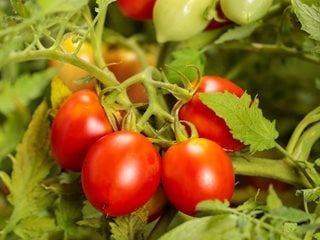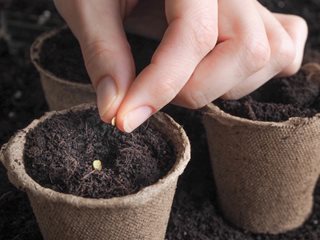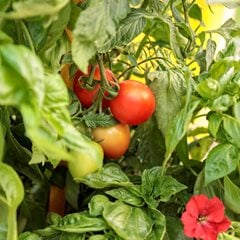Growing Tomatoes From Seed: Your Ultimate Guide
Learn how to grow tomatoes from seed, even if you're a beginner Reviewed by Denise Kelly, Horticulturist
Tempting Tomatoes® 'Garden Gem' tomato. Photo by: Proven Winners.
Imagine going into your garden and plucking a tomato off the vine that you grew from seed. There's a huge difference in flavor (and satisfaction) between a homegrown tomato and one you buy in the grocery store. Plus, you'll save money when you grow your own.
Maybe you're ready to start growing tomatoes in your garden, but you're feeling intimidated. Don't be! Growing tomatoes from seed is easier than you think. All you need to do is to follow these simple steps.
HOW TO PLANT TOMATO SEEDS: SUPPLIES YOU'LL NEED
You'll need some basic gardening supplies as well as the tomato seeds.
Tomato seeds:
Tomato seeds can be found at your local garden center, ordered online, or from a seed catalog.
One way to choose what to grow is to think about how you plan to eat or cook with these tomatoes. Growing a few different types gives you more culinary options. Here are some suggestions:
- Heirloom - burgers and sandwiches
- Beefsteak - BLTs, caprese, and burgers
- Cherry - snacking, skewers, and salads
- Roma - canning
There are thousands of varieties of tomatoes that can be broken down into seven main types. Explore 26 different individual varieties of tomatoes in this video—you're sure to find one or two perfect for beginners! Still not sure what type of seeds you want to plant? Ask your local garden center for recommendations.
Potting mix:
You'll also need a seed-starting mix or potting soil. If you're using garden soil, make sure it's sterile, or it can introduce harmful pathogens which can hurt your tomatoes. Many gardeners use a soilless germinating mixture, which you'll need to wet down before placing in your containers.
Seed-starting containers:
There are various containers designed for growing tomatoes from seed:
- Starter trays are either plastic or biodegradable and are meant for seeds.
- Eco-friendly seed pots or peat pots allow you to plant the entire container straight into the garden.
- Other recycled small containers or egg cartons can also be used.
Avoid using containers that are too large, as this can cause the soil to retain too much moisture. Tomatoes need warm and humid environments to grow, and a domed growing tray creates an ideal environment. Another low-budget option to create a "germination station" is to use plastic wrap.
Optional supplies:
Some supplies are optional but helpful for gardening and especially for growing tomatoes from seed. Here are some items you might want to invest in:
- Hand trowel
- Gardening gloves
- Heat mat
- Soil thermometer
- Moisture meter
- Grow light
- Labels or plant markers
- Spray bottle
WHEN TO PLANT TOMATO SEEDS
Generally, you want to plant tomato seeds around 5-8 weeks before your last expected frost. Check the instructions on your seed packet for specific timing recommendations. If you're behind schedule, you can still grow tomatoes outdoors by planting starter plants instead.
HOW TO GROW TOMATOES FROM SEED

Photo by: Stanislav71 / Shutterstock.
Now that you have your supplies, we'll walk you through some step-by-step instructions. These next steps cover care instructions, and general tips for planting tomato seeds.
Prepare the soil.
The first step is to make sure the soil is ready to use. The packaging should contain further instructions to ensure a successful planting. If you're using pellets, you need to moisten them prior to placing them in the tray. Fill each cell or container loosely, and then tap it gently to remove air pockets.
Plant your tomato seeds.
One mistake new gardeners make is placing too many seeds in a cell. If you're using a new packet of seeds, you can use one per cell. If you're using older seeds or you're unsure how old the seed packet is, sow 2-3 seeds in a cell. This will compensate for any seeds that don't germinate.
Plant the seeds no deeper than 1/4". You can create a tiny hole to place them or gently press them down and cover them with a bit of sterile planting mix. Smooth the soil but be careful not to push too hard. Write the name of the variety and the date you sowed them on labels or plant markers.
Gently water the seeds.
Water once or twice a day when you notice the surface soil is dry. A spray bottle makes it easy to water seedlings. Moisten the soil, but avoid overwatering. This usually takes about 4-5 squirts. You can upgrade to a teapot or small watering can when your tomato plants start to grow bigger. If you'd like to more closely monitor moisture levels, a moisture gauge is an option.
Cover the tray and keep the plants warm.
Use a cover for your newly planted tomato seeds to hold in moisture and heat. This assists in the germination process and ensures the best chances for success. Make sure your cover provides enough room for the seedlings to sprout without bumping the top.
Set the seedlings in a warm location, such as a sunny window, or use a heat mat to keep your tomato seedlings in their ideal temperature range. To further ensure the soil is at the right temperature, invest in a soil thermometer. Keep the seedlings in as much light as possible so they don't stretch or become spindly. If daytime temperatures are above 50 degrees F, they can go outside during the day, but don't forget to bring them back inside. Growth can be stunted in lower temps.
GERMINATION AND TRANSPLANTING FAQS

Photo by: sirichai chinprayoon / Shutterstock.
How long does it take for tomato seeds to germinate indoors?
Usually, tomato seeds germinate in 5 to 10 days. This can vary slightly depending on their environment and the variety you picked.
When should I thin my tomato seedlings?
Give your tomato seedlings more space and nutrients, by thinning them at 2 to 3 weeks or when they are 3 to 4 inches tall. Simply pull a seedling gently upwards to thin your tomato plants or cut close to the soil.
Do I have to harden off tomatoes?
Harden off your tomato plants to reduce the shock when transplanting outside. About 7 to 10 days before transplanting them, set your plants outdoors to acclimate them to wind, sun, and temperature differences. This helps your plants toughen up prior to transplanting.
When should I transplant tomatoes?
Replant tomato seedlings into a larger pot once they have two or three sets of true leaves, or transplant them into the garden if the conditions are right. Note that tomatoes should not be planted outdoors until at least two weeks after your average last frost date.
How long does it take tomatoes to grow from seed?
Once you're tomatoes have been planted outside, expect to harvest and eat your tomates in about 40-75 days.
If you love tomatoes and want to grow your own, start with these tips. Soon you'll be growing tomatoes from seed, and enjoying fresh, homegrown tomatoes from your own garden.
Tempting Tomatoes®
One of the easiest ways to ensure healthy plants is to grow disease-resistant varieties, such as:
MORE ON GROWING TOMATOES:
How to Grow Tomato Plants
Tomato Diseases & Pests
Staking Tomatoes: A Simple How-To Guide
Growing Tomatoes in Pots



